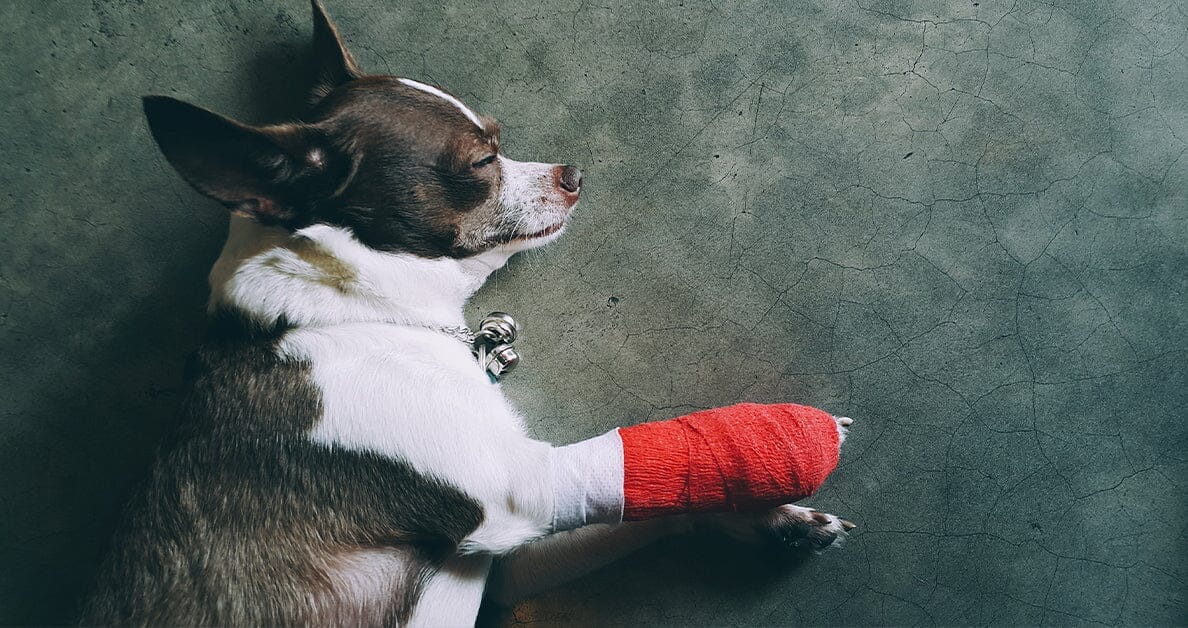It's a beautiful scene to watch a puppy or an adult dog romping around happy and healthy while enjoying the sniffs and activities they love best. There's nothing more joyful than being in the presence of your canine companion and watching them run wild and free just for the fun of it. However, when an illness or condition permeates a dog's body and the spark they had is somehow gone -- even if it’s only temporarily -- it's time to investigate what's going on with your pup and prepare your options for treatment.
Because dogs are unable to speak and let you know what's ailing them, it's vital to understand the signs and symptoms with their every move -- especially when their health appears 'off' in some way. If you suddenly see your dog limping or your dog in pain the first priority is to figure out 'why is my dog limping?' This is quickly followed by trying to get to the root of it so that you can help stop that pain as quickly as possible.
One of the conditions that dogs may suffer from that can cause them to miss a stride is referred to the as luxating patella. You might even ask yourself 'what is luxating patella in dogs', if my dog is limping does it mean he has this condition, and if so, what can I do about it?
We’re here to help answer these questions and even provide some natural home remedies and treatments you can use to help your pup live a happier, pain-free life.
What is Luxating Patella in Dogs?
Going for walks with your dog speaks volumes to your connection, yet if your four-legged family member has leg pain and is unable to go for any distance, it's time to have a professional diagnosis from your veterinarian. Luxating patella in dogs does creates a lot of pain for them, however, there are options for treatment, including dietary considerations, when choosing to undergo rehabilitation and long-term healing.

Luxating patella is sometimes referred to as a dog having a ‘bum knee’. In fact, this condition occurs when the dog’s kneecap -- or patella -- which sits in a groove at the lower end of the thigh bone and naturally moves up and down when the dog's knee is in motion, somehow pops out of alignment and thus causes them pain. In some dogs, the kneecap will dislocate and veer toward the inside or the outside of the leg causing your pup to limp. Their stride changes, they might hop on one leg, hold the luxating patella leg up, or take it upon themselves to stretch their leg out behind them in an attempt to get the kneecap back in position.
Once the kneecap is back to its correct placement, your dog will walk normally again. Luxating patella is one of the most common causes when the dog is lame. The condition doesn't discriminate as both large and small breed dogs may be affected, however, medial patellar luxation (MPL) (the top of the kneecap, often referred to as a 'trick' knee) in smaller dogs is 12 times higher than larger bred dogs. Lateral patellar luxation (LPL) which affects the outside of the kneecap, occurs less frequently and affects larger and giant bred dogs versus the smaller breeds.
Another interesting note is that the female canine is more predisposed to develop luxating patella than males. When you recognize the consistency with your dog's inability to walk comfortably and seeming as though they have a sprained leg, the patella luxation you see is typically diagnosed early in their formative years as young adults, prior to being 3 years of age.
The Age and Breeds of Dogs that Luxating Patella Affects Most
The dogs most susceptible to patella luxation are the following:
- Chihuahua
- Miniature Poodle
- Pomeranian
- Boston Terrier
- Yorkshire Terrier

Any of the above toy breeds are typically born with this congenital condition. The larger breeds of Akita and Great Pyrenees can also be prone to luxating patella syndrome, yet the condition more commonly shows up in the smaller ones mentioned above. The soft tissue that supports the kneecap may be too tight on the inside of the patella and too loose on the outside, thus leading the kneecap to pull to the outskirts of your dog's leg.
To make matters worse, if the groove that the bone sits in is too shallow during standing and long walks with your pup, the tendon that attaches the kneecap to the shin bone may be too far to the inside, so it wants to pull the kneecap over. Often diagnosed more in puppies than adults, a luxating patella is determined during a physical exam when your veterinarian watches the canine's gait and bases the grade and severity of the problem at that point.
Can a Dog Live with Luxating Patella?
A luxating patella simply means that the kneecap is out of place. While it appears as though your dog tolerates the condition on its own, and you may notice a skip in their step on occasion as they're getting the kneecap back in place, it's as if your pup returns to normal walking like nothing ever happened. But living with a luxating patella long-term could be a different story.

Depending on the grade of the luxation and whether it's one leg afflicted or two, it's possible that your dog can tolerate this condition for its entire life. Yet, patella luxation can also be a predisposition to other knee injuries for your dog, such as a torn cruciate ligament. Your veterinarian will determine the severity of the grade and decide the best treatment -- if any -- and how to go from there. Remember that the weight-bearing stress on your pup's knee alters their gait, which can present a problem down the road and lead to changes in the dog's hips, thighs, and shin bones. Also, as time goes on, this could lead to an increased predisposition to your dog getting arthritis later in life if the luxating patella isn't addressed at some point.
Is Luxating Patella Painful for Dogs?
A decrease in your canine companions' mobility is probably more painful for you to watch than the actual pain it is for them to experience. However, if the condition progresses and your dog needs surgery, the rehabilitation and post-surgery recovery can also be difficult and needs to be done carefully. Dogs are also not ones to always let you know when they're in pain; in fact, your fur buddy might simply keep going and never alert you to what's up until the pain actually worsens and affects their overall well-being. Having an occasional hiccup in their step is one thing, but experiencing intermittent pain in their leg due to long-term luxating patella and having it develop into severe arthritis is altogether different and needs to be dealt with.

Whether your dog limping is very pronounced or you notice the kneecap go out only when they’ve overdone it at the dog park, it is always best to have them checked by your vet so that they can diagnose and if in fact, it is luxating patella – they can grade the severity of the condition. The higher the grade of patella luxation, the more your dog may whine when putting pressure on that leg.
If your dog does show signs of pain when they either sprint and the kneecap goes out, or on a long walk where they simply can't put any more weight on the affected leg there are things you can do to help ease your dog’s pain.
Can a Luxating Patella Correct Itself?
If your dog has recurring lameness or if other knee injuries show up as a result of the long-term luxating patella, it's a sign that the kneecap is not correcting itself, but instead leading to a more severe bone condition. The instability of the kneecap is what's at stake here and will determine whether the luxating patella can correct itself. There's a manual fix and there's a surgical fix.
The lower the grade of luxation, the more easily your dog can get help and feel better with some of the alternative treatment options described below. For some dogs, as the kneecap spontaneously 'goes out' during a walk, the dog is able to correct it by stretching the leg as previously mentioned. After several months or years of this change in your dog's movement, the inner side of the groove in the thigh bone may wear down and the kneecap is then free to slide toward the inside of the knee thereby “fixing” the problem.
Alternative and Additional Treatment Options
Treatments for luxating patella in dogs usually consist of pain management with analgesics and nonsteroidal anti-inflammatory drugs (NSAIDs) prescribed by a vet. However, if the condition is not too serious and you are looking for more natural alternative treatments to help ease your dog’s pain, including some you can do at home, a number of options are available. Even dogs with more serious conditions can benefit from these pain relief treatments.
Cold Packs
Applying cold packs to the knee can help reduce inflammation and is easily performed at home. Applying low temperature to the area has several therapeutic effects:
- Causes blood vessels to constrict, thereby decreasing blood flow
- Reduces inflammation and swelling caused by injury or over stimulation
- Decreases pain transmission along the nerve, thereby reducing muscle spasms

The cold pack needs to be malleable to conform to the dog’s leg or knee and should be applied predominantly during the first 24 to 72 hours after injury/acute inflammation. Apply cold packs to the treatment area for 15 to 25 minutes at a time, with a towel or cloth between the ice pack and the dog’s skin to prevent skin damage. A wet towel will allow more rapid cooling than a dry towel.
Natural Pain Relief Remedies
When your pup is in pain, the first thing you want to do is make the pain stop as quickly as possible. However, getting to the vet is not always possible, so if you are wondering “what can I give my dog for pain?” below are a number of natural and over-the-counter treatments that you can try at home.
Turmeric – one of the best-known and most widely used medicinal herbs to treat joint pain and inflammation. Turmeric, which is one of the active ingredients in curcumin, is a powerful antioxidant that neutralizes free radicals that cause inflammation and joint damage. But be careful, as too much turmeric can also cause stomach upset and make the blood thinner.
Hawthorn – another herb used widely amongst holistic vets and herbalists to relieve pain in Hawthorn. According to some doctors who study Chinese medicine methods, by moving blood around and not keeping it stagnant in the body, Hawthorn can help decrease pain. One word of caution: Hawthorn should not be used for pets with a heart condition as it can interact with many prescription drugs that are commonly used to treat high blood pressure and heart disease.
WALK-EASY Joint and Pain relief for dogs – is a well-established natural homeopathic remedy comprised of select plants and cell salts that have been used for centuries to reduce inflammation, support joint movement, and provide effective pain relief for both acute as well as chronic joint problems. WALK-EASY Joint and Hip Pain Relief remedy or WALK-EASY Extra Strength Arthritis and Joint pain relief are safe and gentle, yet powerful ways to ease joint stiffness, reduce pain, and improve mobility for dogs.
Acupuncture for Dogs – an ancient Chinese therapy that has been adopted by many in the West has also been shown to help increase blood flow and reduce inflammation. Although this form of treatment is mostly used for people, it has been shown to be very effective for dogs as well.
Physical Therapy for Dogs
After you have relieved the dog’s pain it is best to focus on strengthening the leg muscles, especially those on the opposite side of the direction of luxation. The primary goals of physical rehabilitation are to reduce pain, increase flexibility, strengthen leg muscle strength, and normalize your dog’s gait.
Check with your physical therapist or massage therapist on what is the best treatment for your dog and make sure that they look at the whole animal, not just the leg or knee. Often dogs with a leg injury will compensate for the condition by putting more weight or stress on other areas of the body. That is why it is important to treat the whole dog.
Dog Leg Exercises
In addition to physical therapy or massage, gentle exercise with your dog can help to strengthen the muscles so that they can hold the bone in place. You can even try many of the following leg muscle strengthening exercises at home yourself, or with a therapist:
- 3-legged and 2-legged stands
- Walking uphill
- Half-squat/sit to stand
- Full-range sit to stand
- Side stepping
- Walking on an underwater treadmill or gentle exercises in a pool is also very helpful as being in the water does not put as much pressure on the joints
Whenever doing exercises, always monitor your dog so as not to over-stress the joints and muscles and cause more pain.
Can Dogs Recover from Luxating Patella?
Sometimes, a luxating patella surgery may be the only course of action to help relieve the condition your dog is suffering from. In this case, and since it's not life-threatening, talk with your veterinarian about available options. Dogs have an incredible capacity to manage to live with patella luxation, yet, developing arthritis and more limited mobility is something to consider when recovering from a luxating patella condition. Surgery may be the only option and the rehabilitation thereafter is basically physical therapy for your dog, not exercising them too hard, and continuing to strengthen the surrounding muscles of the kneecap until they're able to return to normal.
Is Luxating Patella Surgery the Answer?
Surgery is always the last option; however, your veterinarian will determine this and come to the best conclusion. Your dog's next step in healing and returning to its healthy self is knowing when and how to support the kneecap so they can walk normally and with zero pain. Luxating patella surgery will vary depending on the severity of the condition and whether your veterinarian surgeon has advanced training in a variety of surgical techniques or not. General veterinarians typically charge less, but it's up to you to gather all the potential surgery information in your initial consultation. Even if you do choose surgery as the best option for your pup, consider some of the natural treatments above to help relieve pain post-surgery and also to strengthen your dog’s weakened muscles. As always, make sure your pup is healed and go slow whenever doing physical therapy after surgery.
And now for the good news…
The good news is that there's hope, as most dogs don't require surgery for a luxating patella. Many dogs can resume their normal life with manual rehabilitation to strengthen the knee joint and surrounding muscles of the affected leg. Oftentimes, all it takes for your pup to return to their normal and playful selves is a little rest and relaxation following a surgery, or if the patella luxation isn't too severe, physical therapy, gentle exercise supported by natural dog pain relief treatments, and a properly nutritious diet that doesn't cause any inflammation.
There is a wide range of available techniques to restore your dog's lameness to normal mobility if you just do a bit of research and trust your gut to find the best solution for your dog. If it's difficult to determine the condition on your own, having your veterinarian make the diagnosis can make it easier for both you and your dog to seek treatment and move forward with the best possible course of action.
Most importantly, don’t wait – if you notice your pup in pain or having trouble walking, get it looked after right away. After all, early detection and prevention are key to having a healthy and vibrant dog.




